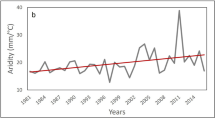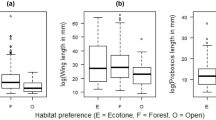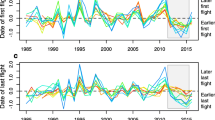Abstract
Species richness patterns along altitudinal gradients are well-documented ecological phenomena, yet very little data are available on how environmental filtering processes influence the composition and traits of butterfly assemblages at high altitudes. We have studied the diversity patterns of butterfly species at 34 sites along an altitudinal gradient ranging from 600 to 2,000 m a.s.l. in the National Park Berchtesgaden (Germany) and analysed traits of butterfly assemblages associated with dispersal capacity, reproductive strategies and developmental time from lowlands to highlands, including phylogenetic analyses. We found a linear decline in butterfly species richness along the altitudinal gradient, but the phylogenetic relatedness of the butterfly assemblages did not increase with altitude. Compared to butterfly assemblages at lower altitudes, those at higher altitudes were composed of species with larger wings (on average 9 %) which laid an average of 68 % more eggs. In contrast, egg maturation time in butterfly assemblages decreased by about 22 % along the altitudinal gradient. Further, butterfly assemblages at higher altitudes were increasingly dominated by less widespread species. Based on our abundance data, but not on data in the literature, population density increased with altitude, suggesting a reversed density–distribution relationship, with higher population densities of habitat specialists in harsh environments. In conclusion, our data provide evidence for significant shifts in the composition of butterfly assemblages and for the dominance of different traits along the altitudinal gradient. In our study, these changes were mainly driven by environmental factors, whereas phylogenetic filtering played a minor role along the studied altitudinal range.




Similar content being viewed by others
References
Beck J, Altermatt F, Hagmann R, Lang S (2010) Seasonality in the altitude-diversity pattern of Alpine moths. Basic Appl Ecol 11:714–722. doi:10.1016/j.baae.2010.08.009
Berger D, Walters R, Gotthard K (2008) What limits insect fecundity? Body size- and temperature-dependent egg maturation and oviposition in a butterfly. Funct Ecol 22:523–529. doi:10.1111/j.1365-2435.2008.01392.x
Berner D, Körner C, Blanckenhorn WU (2004) Grasshopper populations across 2000 m of altitude: is there life history adaptation? Ecography 27:733–740. doi:10.1111/j.0906-7590.2005.04012.x
Börschig C, Klein A-M, von Wehrden H, Krauss J (2013) Traits of butterfly communities change from specialist to generalist characteristics with increasing land-use intensity. Basic Appl Ecol 14:547–554. doi:10.1016/j.baae.2013.09.002
Braby M (2002) Life history strategies and habitat templets of tropical butterflies in north-eastern Australia. Evol Ecol 16:399–413. doi:10.1023/A:1020226426031
Brehm G, Fiedler K (2004) Bergmann’s rule does not apply to geometrid moths along an elevational gradient in an Andean montane rain forest. Glob Ecol Biogeogr 13:7–14. doi:10.1111/j.1466-882X.2004.00069.x
Brehm G, Strutzenberger P, Fiedler K (2013) Phylogenetic diversity of geometrid moths decreases with elevation in the tropical Andes. Ecography 36:1247–1253. doi:10.1111/j.1600-0587.2013.00030.x
Carnicer J, Brotons L, Stefanescu C, Penuelas J (2012) Biogeography of species richness gradients: linking adaptive traits, demography and diversification. Biol Rev 87:457–479. doi:10.1111/j.1469-185X.2011.00210.x
Chown SL, Klok CJ (2003) Altitudinal body size clines: latitudinal effects associated with changing seasonality. Ecography 26:445–455. doi:10.1034/j.1600-0587.2003.03479.x
Chown SL, le Roux PC, Ramaswiela T et al (2012) Climate change and elevational diversity capacity: do weedy species take up the slack? Biol Lett. doi:10.1098/rsbl.2012.0806
Colwell RK, Rahbek C, Gotelli NJ (2004) The mid-domain effect and species richness patterns: what have we learned so far? Am Nat 163:E1–E23. doi:10.1086/382056
Cornwell WK, Ackerly DD (2009) Community assembly and shifts in plant trait distributions across an environmental gradient in coastal California. Ecol Monogr 79:109–126. doi:10.1890/07-1134.1
Cowley M, Thomas C, Roy D et al (2001) Density-distribution relationships in British butterflies. I. The effect of mobility and spatial scale. J Anim Ecol 70:410–425. doi:10.1046/j.1365-2656.2001.00508.x
Diamond SE, Frame AM, Martin RA, Buckley LB (2011) Species’ traits predict phenological responses to climate change in butterflies. Ecology 92:1005–1012
Dillon M, Frazier M, Dudley R (2006) Into thin air: physiology and evolution of alpine insects. Integr Comp Biol 46:49–61. doi:10.1093/icb/icj007
Dunne JA, Saleska SR, Fischer ML, Harte J (2004) Integrating experimental and gradient methods in ecological climate change research. Ecology 85:904–916. doi:10.1890/03-8003
Fischer K, Fiedler K (2001) Egg weight variation in the butterfly Lycaena hippothoe: more small or fewer large eggs? Popul Ecol 43:105–109. doi:10.1007/PL00012009
Garcia-Barros E (2000) Body size, egg size, and their interspecific relationships with ecological and life history traits in butterflies (Lepidoptera: Papilionoidea, Hesperioidea). Biol J Linn Soc 70:251–284. doi:10.1111/j.1095-8312.2000.tb00210.x
García-Barros E, Fartmann T (2009) Butterfly oviposition: sites, behaviour and modes. In: Settele J, Shreeve T, Konvicka M, Van Dyck H (eds) Ecology of butterflies in Europe. Cambridge University Press, Cambridge, pp 29–42
Gaston K, Blackburn T (2000) Pattern and process in macroecology. Blackwell Science, Oxford
Gaston KJ, Chown SL, Evans KL (2008) Ecogeographical rules: elements of a synthesis. J Biogeogr 35:483–500. doi:10.1111/j.1365-2699.2007.01772.x
Gibbs M, Lace L, Jones M, Moore A (2005) Egg size-number trade-off and a decline in oviposition site choice quality: female Pararge aegeria butterflies pay a cost of having males present at oviposition. J Insect Sci 5:1–9
Grafen A (1989) The phylogenetic regression. Philos Trans R Soc Lond Ser B Biol Sci 326:119–157. doi:10.1098/rstb.1989.0106
Hawkins B, DeVries P (1996) Altitudinal gradients in the body sizes of Costa Rican butterflies. Acta Oecol 17:185–194
Higgins LG, Riley ND (1971) Die Tagfalter Europas und Norwestafrikas. Paul Parey, Hamburg
Hodkinson I (2005) Terrestrial insects along elevation gradients: species and community responses to altitude. Biol Rev 80:489–513. doi:10.1017/S1464793105006767
Hoiss B, Krauss J, Potts SG et al (2012) Altitude acts as an environmental filter on phylogenetic composition, traits and diversity in bee communities. Proc Biol Sci 279:4447–4456. doi:10.1098/rspb.2012.1581
Hoiss B, Gaviria J, Leingärtner A et al (2013) Combined effects of climate and management on plant diversity and pollination type in alpine grasslands. Divers Distrib 19:386–395. doi:10.1111/j.1472-4642.2012.00941.x
Hunter M, Yonzon P (1993) Altitudinal distributions of birds, mammals, people, forests, and parks in Nepal. Conserv Biol 7:420–423. doi:10.1046/j.1523-1739.1993.07020420.x
Jones JI, Li W, Maberly SC (2003) Area, altitude and aquatic plant diversity. Ecography 26:411–420. doi:10.1034/j.1600-0587.2003.03554.x
Junker M, Wagner S, Gros P, Schmitt T (2010) Changing demography and dispersal behaviour: ecological adaptations in an alpine butterfly. Oecologia 164:971–980. doi:10.1007/s00442-010-1720-3
Karl I, Janowitz SA, Fischer K (2008) Altitudinal life-history variation and thermal adaptation in the copper butterfly Lycaena tityrus. Oikos 117:778–788. doi:10.1111/j.2008.0030-1299.16522.x
Kissling WD, Carl G (2008) Spatial autocorrelation and the selection of simultaneous autoregressive models. Glob Ecol Biogeogr 17:59–71. doi:10.1111/j.1466-8238.2007.00334.x
Komonen A, Grapputo A, Kaitala V et al (2004) The role of niche breadth, resource availability and range position on the life history of butterflies. Oikos 105:41–54. doi:10.1111/j.0030-1299.2004.12958.x
Konvicka M, Zimmermann K, Klimova M et al (2012) Inverse link between density and dispersal distance in butterflies: field evidence from six co-occurring species. Popul Ecol 54:91–101. doi:10.1007/s10144-011-0277-2
Krauss J, Steffan-Dewenter I, Tscharntke T (2003) How does landscape context contribute to effects of habitat fragmentation on diversity and population density of butterflies? J Biogeogr 30:889–900. doi:10.1046/j.1365-2699.2003.00878.x
Kudrna O, Harpke A, Lux K et al (2011) Distribution atlas of butterflies in Europe. Gesellschaft für Schmetterlingsschutz, Halle
Kuras T, Benes J, Fric Z, Konvicka M (2003) Dispersal patterns of endemic alpine butterflies with contrasting population structures: Erebia epiphron and E. sudetica. Popul Ecol 45:115–123. doi:10.1007/s10144-003-0144-x
Lenoir J, Gégout JC, Marquet PA et al (2008) A significant upward shift in plant species optimum elevation during the 20th century. Science 320:1768–1771. doi:10.1126/science.1156831
Lomolino MV (2000) Ecology’s most general, yet protean pattern: the species–area relationship. J Biogeogr 27:17–26. doi:10.1046/j.1365-2699.2000.00377.x
Mangel M, Rosenheim J, Adler F (1994) Clutch size, offspring performance, and intergenerational fitness. Behav Ecol 5:412–417. doi:10.1093/beheco/5.4.412
Mittelbach GG, Schemske DW, Cornell HV et al (2007) Evolution and the latitudinal diversity gradient: speciation, extinction and biogeography. Ecol Lett 10:315–331. doi:10.1111/j.1461-0248.2007.01020.x
Nogues-Bravo D, Araujo MB, Romdal T, Rahbek C (2008) Scale effects and human impact on the elevational species richness gradients. Nature 453:216–220. doi:10.1038/nature06812
Nylin S (2009) Gradients in butterfly biology. In: Settele J, Shreeve T, Konvicka M, Van Dyck H (eds) Ecology of butterflies in Europe. Cambridge University Press, Cambridge, pp 198–216
Päivinen J, Grapputo A, Kaitala V et al (2005) Negative density-distribution relationship in butterflies. BMC Biol 3:5. doi:10.1186/1741-7007-3-5
Paradis E, Claude J, Strimmer K (2004) APE: analyses of phylogenetics and evolution in R language. Bioinformatics 20:289–290
Parmesan C (2006) Ecological and evolutionary responses to recent climate change. In: Annual review of ecology evolution and systematics, vol. 37. Annual Reviews, Palo Alto, pp 637–669
Pellissier L, Fiedler K, Ndribe C et al (2012a) Shifts in species richness, herbivore specialization, and plant resistance along elevation gradients. Ecol Evol 2:1818–1825. doi:10.1002/ece3.296
Pellissier L, Litsios G, Fiedler K et al (2012b) Loss of interactions with ants under cold climate in a regional myrmecophilous butterfly fauna. J Biogeogr 39:1782–1790. doi:10.1111/j.1365-2699.2012.02743.x
Pellissier L, Alvarez N, Espíndola A et al (2013) Phylogenetic alpha and beta diversities of butterfly communities correlate with climate in the western Swiss Alps. Ecography 36:541–550. doi:10.1111/j.1600-0587.2012.07716.x
R Core Team (2012) R: a language and environment for statistical computing. R Foundation for Statistical Computing, Vienna
Rahbek C (1995) The elevational gradient of species richness: a uniform pattern? Ecography 18:200–205. doi:10.1111/j.1600-0587.1995.tb00341.x
Roland J, Keyghobadi N, Fownes S (2000) Alpine Parnassius butterfly dispersal: effects of landscape and population size. Ecology 81:1642–1653. doi:10.1890/0012-9658(2000)081[1642:APBDEO]2.0.CO;2
Schweizerischer Bund für Naturschutz (1994) Tagfalter und ihre Lebensräume. Arten-Gefährdung-Schutz. Fotorotar AG, Basel
Segerer A, Hausmann A, Behounek G et al (2011) Die Großschmetterlinge Deutschlands. The Macrolepidoptera of Germany. Goecke and Evers, Keltern
Settele J, Feldmann R, Reinhardt R (1999) Die Tagfalter Deutschlands. Ulmer, Stuttgart
Sonderegger P (2005) Die Erebien der Schweiz (Lepidoptera: Satyrinae, Genus Erebia). Peter Sonderegger, Brügg bei Biel
Stettmer C, Bräu M, Gros P, Wanninger O (2007) Die Tagfalter Bayerns und Österreichs. Bayerische Akademie für Naturschutz und Landschaftspflege, Laufen/Salzach
Stevens G (1992) The elevational gradient in altitudinal range: an extension of Rapoport’s latitudinal rule to altitude. Am Nat 140:893–911. doi:10.1086/285447
Thomas JA (2005) Monitoring change in the abundance and distribution of insects using butterflies and other indicator groups. Philos Trans R Soc Lond B Biol Sci 360:339–357. doi:10.1098/rstb.2004.1585
Thomas JA, Telfer MG, Roy DB et al (2004) Comparative losses of British butterflies, birds, and plants and the global extinction crisis. Science 303:1879–1881. doi:10.1126/science.1095046
Vazquez J, Givnish T (1998) Altitudinal gradients in tropical forest composition, structure, and diversity in the Sierra de Manantlan. J Ecol 86:999–1020
Violle C, Enquist BJ, McGill BJ et al (2012) The return of the variance: intraspecific variability in community ecology. Trends Ecol Evol 27:244–252. doi:10.1016/j.tree.2011.11.014
Wagner KD, Krauss J, Steffan-Dewenter I (2011) Changes in the life history traits of the European Map butterfly, Araschnia levana (Lepidoptera: Nymphalidae) with increase in altitude. Eur J Entomol 108:447–452
Webb CO, Ackerly DD, McPeek MA, Donoghue MJ (2002) Phylogenies and community ecology. Annu Rev Ecol Syst 33:475–505. doi:10.1146/annurev.ecolysis.33.010802.150448
Weidemann HJ (1995) Tagfalter: beobachten, bestimmen. Naturbuch Verlag, Augsburg
Acknowledgments
We thank Carmen Börschig, Bernhard Hoiß and Yu-Lung Hsieh for valuable comments on the manuscript; Bernhard Hoiß also for his help in the field and the lab; Jürgen Hensle and Peter Sonderegger for their help with the life-history traits of alpine butterflies; Julian Bittermann, Alfred Haslberger and the “Arbeitsgemeinschaft Bayerischer Entomologen e.V.” for taxonomic support; Michael Vogel, Helmut Franz and the National Park Berchtesgaden for the permission to work in the national park and the owners of the study sites outside the national park for their cooperation; Elisabeth Sieger for the kind care in the research station Ramsau. This study was pursued within the framework of the joint research centre FORKAST and was funded by the “Bavarian Climate Programme 2020”.
Author information
Authors and Affiliations
Corresponding author
Additional information
Communicated by Konrad Fiedler.
Electronic supplementary material
Below is the link to the electronic supplementary material.
Rights and permissions
About this article
Cite this article
Leingärtner, A., Krauss, J. & Steffan-Dewenter, I. Species richness and trait composition of butterfly assemblages change along an altitudinal gradient. Oecologia 175, 613–623 (2014). https://doi.org/10.1007/s00442-014-2917-7
Received:
Accepted:
Published:
Issue Date:
DOI: https://doi.org/10.1007/s00442-014-2917-7




